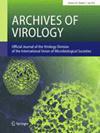新噬菌体GaoY1-9D的全基因组序列分析
IF 2.5
4区 医学
Q3 VIROLOGY
引用次数: 0
摘要
本研究从农场污水样品中分离到一种新的埃希氏噬菌体GaoY1-9D并对其进行了测序。基因组长度为50368 bp, G + C含量为46.46%。噬菌体GaoY1-9D的基因组为双链环状DNA,两端有127 bp的末端重复序列,不含tRNA基因。根据基因组序列比较结果,大肠埃希菌噬菌体GaoY1-9D是德雷克斯勒病毒科的一个新种。本文章由计算机程序翻译,如有差异,请以英文原文为准。
Complete genome sequence analysis of a new Escherichia phage, GaoY1-9D
In this study, a new Escherichia phage, GaoY1-9D, was isolated from farm sewage samples and sequenced. Its genome length is 50,368 bp, and its G + C content is 46.46%. The genome of phage GaoY1-9D is a double-stranded circular DNA that has 127-bp terminal repeats at both ends and does not contain any tRNA genes. Based on the results of genome sequence comparisons, Escherichia phage GaoY1-9D represents a new species in the family Drexlerviridae.
求助全文
通过发布文献求助,成功后即可免费获取论文全文。
去求助
来源期刊

Archives of Virology
医学-病毒学
CiteScore
5.10
自引率
7.40%
发文量
324
审稿时长
4.5 months
期刊介绍:
Archives of Virology publishes original contributions from all branches of research on viruses, virus-like agents, and virus infections of humans, animals, plants, insects, and bacteria. Coverage spans a broad spectrum of topics, from descriptions of newly discovered viruses, to studies of virus structure, composition, and genetics, to studies of virus interactions with host cells, organisms and populations. Studies employ molecular biologic, molecular genetics, and current immunologic and epidemiologic approaches. Contents include studies on the molecular pathogenesis, pathophysiology, and genetics of virus infections in individual hosts, and studies on the molecular epidemiology of virus infections in populations. Also included are studies involving applied research such as diagnostic technology development, monoclonal antibody panel development, vaccine development, and antiviral drug development.Archives of Virology wishes to publish obituaries of recently deceased well-known virologists and leading figures in virology.
 求助内容:
求助内容: 应助结果提醒方式:
应助结果提醒方式:


